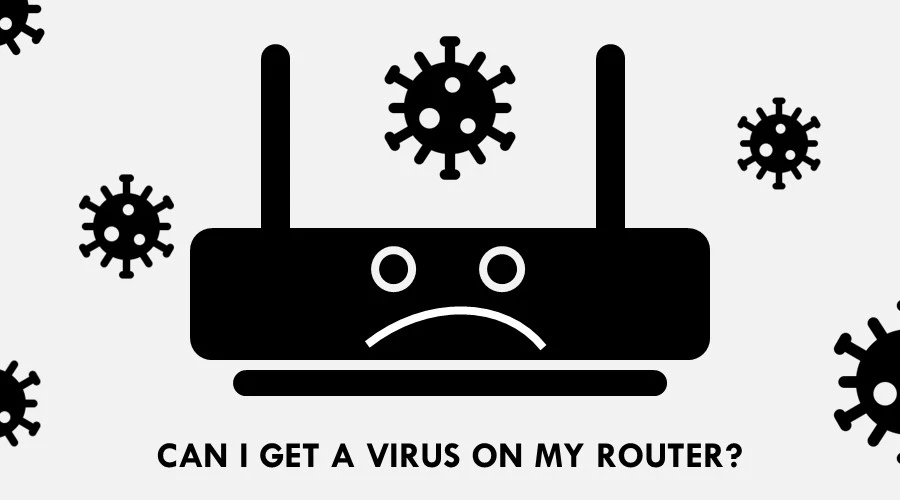Can I Get a Virus on My Router? Everything You Need To Know

We don’t often think of our routers — until the moment something goes wrong. Once that happens, you might start wondering Can I get a virus on my router?
Well, look no further.
In this article, we’ll explain whether router malware is possible and how you can get infected. Moreover, we’ll share safety tips to prevent such incidents from reoccurring. Let’s do this!
Can I get a virus on my router?
Yes, you can get a virus on your router. It has an operating system (OS), which automatically means it’s vulnerable to attacks.
A popular example includes VPNFilter. It’s a type of malware designed for compromising network installations. First reported in 2018, it has wrecked 500,000+ devices in over 50 countries so far.
And VPNFilter isn’t the only one:
Mirai and Meris now account for over 50% of router viruses. These two are more sophisticated, especially for launching enterprise-level DDoS attacks.
But how do viruses get into routers?
Here are some of the most common scenarios:
Password-guessing
Vendors sell internet routers with readily available admin usernames and passwords. This is convenient for users during the configuration process.
Unfortunately, default credentials are easy to look up on the internet, and most users forget to change them. Hackers can then guess their way into routers and infect them as they please.
Phishing attacks
Cybercriminals may also send victims legitimate-looking emails to trick them into providing sensitive information. For example, they can ask for your router’s login credentials under the guise of tech support.
They usually instill a sense of urgency in their messages and make their requests hard to ignore.
Additionally, the messages may contain harmful links and attachments. Clicking or opening them will trigger malware installation.
Router vulnerabilities
Routers, like any other device, have security loopholes that hackers can abuse. That includes software bugs, bad configurations, weak encryptions, open ports, and more.
Cybercriminals go the extra mile to look for such exploits on networking equipment.
What are the potential threats?
Router malware can have dire consequences. Below are some of the risks you stand to face:
Data theft
A cybercriminal that hacks your router can remotely track everything you do. That includes your web activities, financial transactions, and shared files.
And that’s not all:
They may monitor other connected devices on your network as well. Examples include CCTVs, smart appliances, home automation hubs, and more. Moreover, the intruder can use the gathered data to threaten you and demand a ransom.
Virus infections
Hackers don’t stop at infecting routers with viruses. They tend to spread malicious software even further, to other devices connected to a hotspot.
Such attacks have a significant impact on enterprise networks and systems. If successful, they can bring business operations to a complete stop.
DNS hijacking
An attacker that hacks into a router can change its default DNS settings and redirect users to harmful websites.
Common ones include phishing sites where victims unknowingly provide personal information. Others may infect you with drive-by downloads.
Botnet attacks
Did you know that your hacked router can become part of a botnet? It’s a network of remotely controlled infected devices used for launching large-scale cyberattacks.
These comprise spam campaigns, credential stuffing, and distributed denial-of-service (DDoS) attacks.
But worry not! We have a solution.
How to remove a virus from your router?
Don’t panic if your router has a virus. The following steps will help you fix it:
- Disconnect the router from the internet.
Routers require you to disconnect them from the web before critical functions.

- Perform a factory reset.
A factory reset restores a device back to its original state. It erases all data, settings, and add-ons, including malware.
- Configure the router.
Power the router after performing the factory reset to reconfigure it. Start by updating the firmware to the latest version. Then, change the admin password to something unique and hard to guess.

- Create a new WiFi network.

Make sure to assign it a unique name and password. You can also add a guest network for your visitors.
How to stay safe?
Knowing how to fix router virus infections is a good thing. But it’s even better to prevent them!
Just follow these recommendations:
- Set a strong and long admin password for your router. It can include a combination of numbers, letters, and special symbols.
- Disable remote access to stop unauthorized users.
- Change the login URL to the admin console if your device allows it.
- Enable your firewall to block unwanted connections.

- Always update router firmware to benefit from bug fixes and security patches.
You’ll now be able to browse with no worries!
Summary
You came here asking, can I get a virus on my router? And now you know it’s possible.
Your router can get infected like any other device powered by an operating system. Cybercriminals mostly rely on phishing attacks, password guessing, and vulnerability exploits to gain access to it.
However, you can now eliminate malware for good thanks to our little guide. Furthermore, our security tips will keep you safe from future mishaps. Good luck!



User forum
0 messages